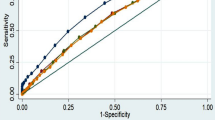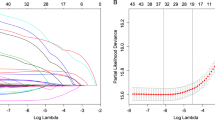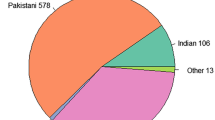Abstract
Background:
Published studies reveal that individuals with lower extremity amputation are vulnerable to cardiovascular diseases (CVD) because of poor physical activity level. Many cardiovascular risk assessment studies have utilized anthropometric traits (primarily body mass index and waist circumference) as cardiovascular risk factor. However, some studies emphasized the technical limitations of measuring waist circumference for studying cardiovascular risk, and so it is difficult to obtain correct measurement from the individuals with lower extremity amputation.
Objectives:
The objectives of the present article are to study the prevalence of CVD risk factors among the individuals with traumatic lower extremity amputation and to test the validity of upper arm circumference (UAC) as an alternative anthropometric measurement for screening the CVD risk condition.
Subjects and setting:
Anthropometric data and other cardiovascular traits data have been collected from unilateral traumatic lower extremity amputated adult males (n=85) residing in Calcutta and adjoining areas.
Results:
Results show higher prevalence of cardiovascular risk factor among individuals with above-knee amputation than below-knee amputation. The receiver operating characteristics curve analysis shows significant ability of upper arm circumference to diagnose cardiovascular risk condition. The cutoff value of UAC>26.6 cm show maximum sensitivity and specificity for the diagnosis of cardiovascular risk condition. Although, binomial tests for equality of proportion does not show any significant difference, however, agreement statistics reveal better diagnostic ability of cutoff value of UAC than the existing cutoff value of waist circumference.
Conclusions:
Therefore, UAC provides a better assessment of cardiovascular risk condition than does waist circumference especially for individuals with lower extremity amputation.
Sponsorship:
Indian Statistical Institute, Kolkata.
This is a preview of subscription content, access via your institution
Access options
Subscribe to this journal
Receive 12 print issues and online access
$259.00 per year
only $21.58 per issue
Buy this article
- Purchase on Springer Link
- Instant access to full article PDF
Prices may be subject to local taxes which are calculated during checkout


Similar content being viewed by others
References
American Diabetes Association (ADA) (2004). Screening for type 2 diabetes. Diabetes Care 27, S11–S14 (position statement).
Beaglehole R, Bonita R, Kjellstron T (1993). The Basic Epidemiology. World Health Organization: Geneva.
Bigaard J, Tjønneland A, Thomsen BL, Overvad K, Heitmann BL, Sørensen TIA (2003). Waist circumference, BMI, smoking, and mortality in middle-aged men and women. Obes Res 11, 895–903.
Bigaard J, Thomsen BL, Tjønneland A, Sørensen TIA (2004). Does waist circumference alone explain obesity-related health risks? Am J Clin Nutr 80, 790–791 (letters to the editor).
Briend A, Gareme M, Maire B, Fontaine O, Dieng K (1989). Nutritional status, age and survival: the muscle mass hypothesis. Eur J Clin Nutr 43, 715–726.
Cohen JA (1960). A coefficient of agreement for nominal scales. Educ Psych Meas 20, 37–46.
Condie E, Jones D, Treweek S, Scott H (1996). A one-year national survey of patients having a lower limb amputation. Physiotherapy 82, 14–20.
Das B, Kozey JW (1994). Measurements of structural anthropometry for wheelchair mobile paraplegics. Proceedings of the 12th Congress of IEA, vol. 3. Rehabilitation, August 15–19; Toronto, Canada.
Drillis R, Contini R (1966). Body segment parameters. Office of Vocational Rehabilitation, Department of Health, Education and Welfare: New York, [Report no. 1166–03.] [retraction from Oborne DJ (ed). 1986. Ergonomics at Work. John Wiley and Sons, Ltd: New York. p 43.
Goswami A, Ganguli S, Chatterjee BB (1987). Anthropometric characteristics of disabled and normal Indian men. Ergonomics 30, 817–823.
Griner PF, Mayewski RJ, Mushlin AI, Greenland P (1981). Selection and interpretation of diagnostic tests and procedures. Ann Intern Med 94, 555–600.
Grundy SM, Pasternak R, Greenland P, Smith Jr SC, Fuster V (1999). Assessment of cardiovascular risk. J Am Coll Cardiol 34, 1348–1359.
Hrubec Z, Ryder RA (1980). Traumatic limb amputation and subsequent mortality from cardiovascular disease and other causes. J Chron Dis 233, 229–250.
James WPT, Mascie-Taylor CG, Norgan NG, Bistrain BR, Shetty PS, Ferro-Luzzi A (1994). The value of arm circumference measurements in assessing chronic energy deficiency in Third World adults. Eur J Clin Nutr 48, 883–894.
Janssen I, Steven HB, Allison DB, Kotler DP, Ross Robert (2002). Body mass index and waist circumference independently contribute to the prediction of nonabdominal, abdominal subcutaneous, and visceral fat. Am J Clin Nutr 75, 683–688.
Janssen I, Katzmarzyk PT, Ross R (2004). Waist circumference and not body mass index explains obesityrelated health risk. Am J Clin Nutr 79, 379–384.
Jarosz E (1994). Anthropometric data of wheelchair users for designers. Proceedings of the 12th Congress of IEA, vol. 3. Rehabilitation, August 15–19; Toronto, Canada.
Kannel WB, Dawber TR, Kagan A, Revotskie N, Stokes III J (1961). Factors of risk in the development of coronary heart disease: six-year follow-up experience – the Framingham Study. Ann Intern Med 55, 33–50.
Lear SA, Chen MM, Frohlich JJ, Birmingham CL (2002). The relationship between waist circumference and metabolic risk factors: cohorts of European and Chinese descent. Metabolism 51, 1427–1432.
Lear SA, Toma M, Birmingham CL, Frohlich JJ (2003). Modification of the relationship between simple anthropometric indices and risk factors by ethnic background. Metabolism 52, 1295–1301.
Madan M, Peles E, Halkin H, Nitzan H, Azaria M, Gitel S et al. (1998). Increased cardiovascular disease mortality rates in traumatic lower limb amputees. Am J Cardiol 82, 1242–1247.
Mozumdar A, Roy SK (2000). A note on the alternative method for the assessment of nutritional status. J Indian Anthropol Soc 35, 197–203.
Mozumdar A, Roy SK (2004). Method for estimation of body weight of lower extremity amputees and its implication on their nutritional assessment. Am J Clin Nutr 80, 868–875.
National Cholesterol Education Program, Expert panel on detection, evaluation, treatment of high blood cholesterol in adults (Adult Treatment Panel III) (2001). Executive Summary of the third report of the National Cholesterol Education Program (NCEP). JAMA 285, 2486–2497.
Oldridge NB, Stump TE (2004). Heart disease, comorbidity, and activity limitation in community-dwelling elderly. Eur J Cardiovasc Prev Rehabil 11, 427–434.
Osterkamp LK (1995). Current perspective on assessment of human body proportions of relevance to amputees. J Am Diet Assoc 95, 215–218.
Pollitt RA, Rose KM, Kaufman JS (2005). Evaluating the evidence for models of life course socioeconomic factors and cardiovascular outcomes: a systematic review. BMC Public Health 5, 7.
Resnick HE, Carter EA, Lindsay R, Henly SJ, Ness FK, Welty TK et al. (2004). Relation of lower-extremity amputation to all-cause and cardiovascular disease mortality in American Indians. Diabetes Care 27, 1286–1293.
Shetty PS, James WPT (1994). Body Mass Index: A Measure of Chronic Energy Deficiency In Adult. Food and Agricultural Organization [FAO: Food and Nutrition paper: No. 56]: Rome.
Tan CE, Ma S, Wai D, Chew SK, Tai ES (2004). Can we apply the National Cholesterol Education Program Adult Treatment Panel definition of the metabolic syndrome to Asians? Diabetes Care 27, 1182–1186.
Wang J, Thornton JC, Bari S, Williamson B, Gallagher D, Heymsfield SB et al. (2003). Comparisons of waist circumferences measured at 4 sites. Am J Clin Nutr 77, 379–384.
Weiner JS, Lourie JA (1981). Practical Human Biology (International Biological Programme Handbook No. 9). Academic Press INC Ltd: London.
Weiss GN, Gorton TA, Read RC, Neal LA (1990). Outcomes of lower extremity amputations. J Am Geriatr Soc 38, 877–883.
World Health Organization (WHO) (2002). Cardiovascular Disease-Prevention and Control. World Health Organization Cardiovascular Diseases Strategy, 2001/2002. Geneva: World Health Organization.
Williams SRP, Goodfellow J, Davies B, Bell W, McDowell I, Jones E (2000). Somatotype and angiographically determined atherosclerotic coronary artery disease in men. Am J Hum Biol 12, 128–138.
Wilson PW, D'Agostino RB, Levy D, Belanger AM, Silbershatz H, Kannel WB (1998). Prediction of coronary heart disease using risk factor categories. Circulation 97, 1837–1847.
Zweig MH, Campbell G (1993). Receiver-operating characteristic (ROC) plots: a fundamental evaluation tool in clinical medicine. Clin Chem 39, 561–577.
Acknowledgements
We are grateful to the subjects who participated in the study for their kind help and cooperation. Financial and logistic support was given to this study by the Indian Statistical Institute, Kolkata. Both the authors participated in study design, data analysis and writing the manuscript. AM collected the field data for the present study. No author had any financial or personal conflict of interest in the organization supporting the research.
Author information
Authors and Affiliations
Corresponding author
Additional information
Guarantor: SK Roy.
Contributors: Both the authors participated in the study design, data analysis and writing the article. AM collected field data.
Rights and permissions
About this article
Cite this article
Mozumdar, A., Roy, S. Validity of an alternative anthropometric trait as cardiovascular diseases risk factor: example from individuals with traumatic lower extremity amputation. Eur J Clin Nutr 60, 1180–1188 (2006). https://doi.org/10.1038/sj.ejcn.1602434
Received:
Revised:
Accepted:
Published:
Issue Date:
DOI: https://doi.org/10.1038/sj.ejcn.1602434



